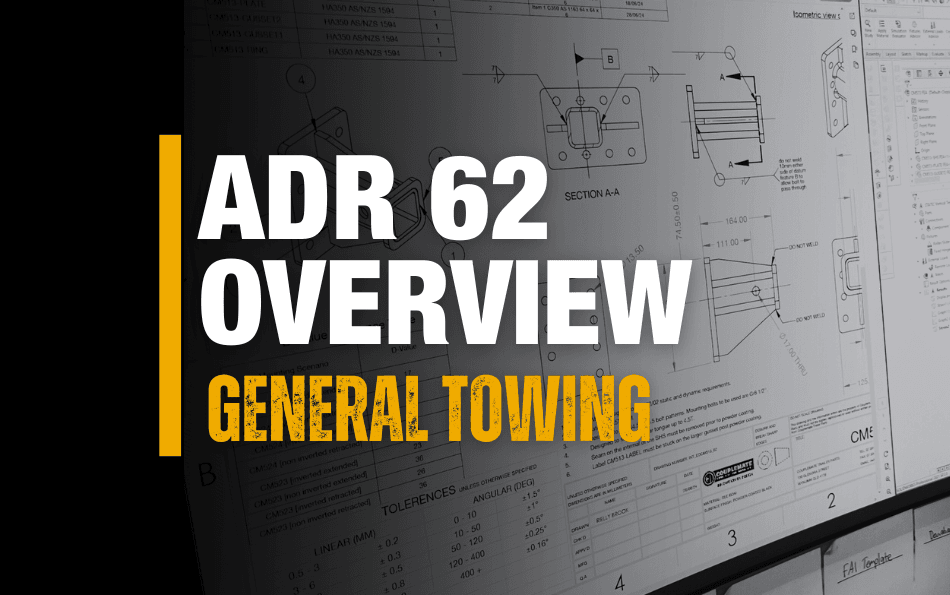
Overview of ADR 62/02 (Mechanical Connections Between Vehicles)
Whether you tow a caravan, horse float, or any kind of trailer, it’s important you understand what towing safety standards exist and how they apply to you. This overview of ADR 62/02 will help frame its importance in safe towing by outlining its key role and function.
Outline of Topics:
- What is ADR 62/02?
- Who needs to comply with ADR 62?
- Which components fall under ADR 62?
- What are some of the important points?
This is the foreword to the Couplemate™ Technical Hub unit on towing (i.e. chapter 0).
Recommend reading to solidify background knowledge: Introduction to Road Vehicle Compliance
What is ADR 62/02?
Our ADRs (Australian Design Rules) are a set of focused rulings that draw from various Australian Standards. In a nutshell, they set benchmarks for safety and are to be enforced by our regulatory bodies.
As we discussed in the Introduction to Road Vehicle Compliance, the RVS (Road Vehicle Standards) is the legal entity that enforces ADR 62/02 as it stems from the Road Vehicle Standards Act 2018.
The Department of Infrastructure, Transport & Vehicles summarises the purpose of ADR 62 as:
“The function of this Australian Design Rule is to specify requirements for devices for mechanical connections between vehicles and their fitment, in order to ensure positive mechanical engagement for vehicle combinations and to prohibit the opening or disengaging of devices under the action of any forces to which they may be subject to during normal use (page source).”
Put very simply, ADR 62 benchmarks safety requirements for vehicle towbars and trailer/caravan drawbars.
What does “/02” mean?
These numbers refer to the ADR’s edition or version. The current version of ADR 62 is “/02” (as of 5 February 2010) and supersedes:
Who needs to comply with ADR 62?
All trailers, caravans, and other towed vehicles to be used on public roads must comply with ADR 62.
Regulatory compliance is largely on the trailer or caravan manufacturer, as the design of the vehicle and its components (whether integral or auxiliary to) must be fit for application. Likewise, this applies to any servicers and repairers wherein work completed must ensure compliance with benchmarked safety standards.
Individuals looking to modify an existing trailer, or to build their own, also must comply. Moreover, with road registration requirements getting stricter, understanding your compliance obligations will save you from needless frustration.
Which components fall under ADR 62?
Components fall under ADR 62 if they are integral, or auxiliary, to forming a mechanical connection between vehicles (hence the name). Put simply, this refers to components on your vehicle’s towbar and your caravan or trailer drawbar. We’ve listed some examples below.
- Vehicle Towbar:
- Trailer Drawbar:
- Couplings and hitches.
- Safety chain (and holders)
- Breakaway systems.
Generally, the best way to discern what ADR may apply to a component is by understanding its function. For example, the core function of a backing plate is to brake, so it would fall under ADR 38 – Trailer Braking Systems. Couplemate™ has a free resource you can download and print if you need help working out what parts fall under what ADR: Caravan ADR Poster.
What are some of the important points?
Below are ten important dot points from ADR 62.
- Trailers in Australia must not be overloaded beyond their maximum capacity.
- Trailer mass must be less than, or equal to, the tow vehicle’s specified maximum towing mass.
- The tow vehicle and trailer must be compatible with each other in terms of weight distribution and braking capacity.
- Drawbars must be constructed from a suitable material and be of sufficient strength to handle the intended load.
- Couplings must meet minimum specified requirements for the intended ATM.
- Couplings should be properly installed, maintained, and adjusted to ensure safe towing.
- An automatic coupler must have a positive locking mechanism.
- Safety chains must be used when towing.
- The safety chain, as well as breakaway, must be attached in the correct manner on the tow vehicle and trailer.
- The towbar, and its components, must be of sufficient design to handle the intended load.
Read the next chapter: Shackles for Safety Chain Connections
0 Comments